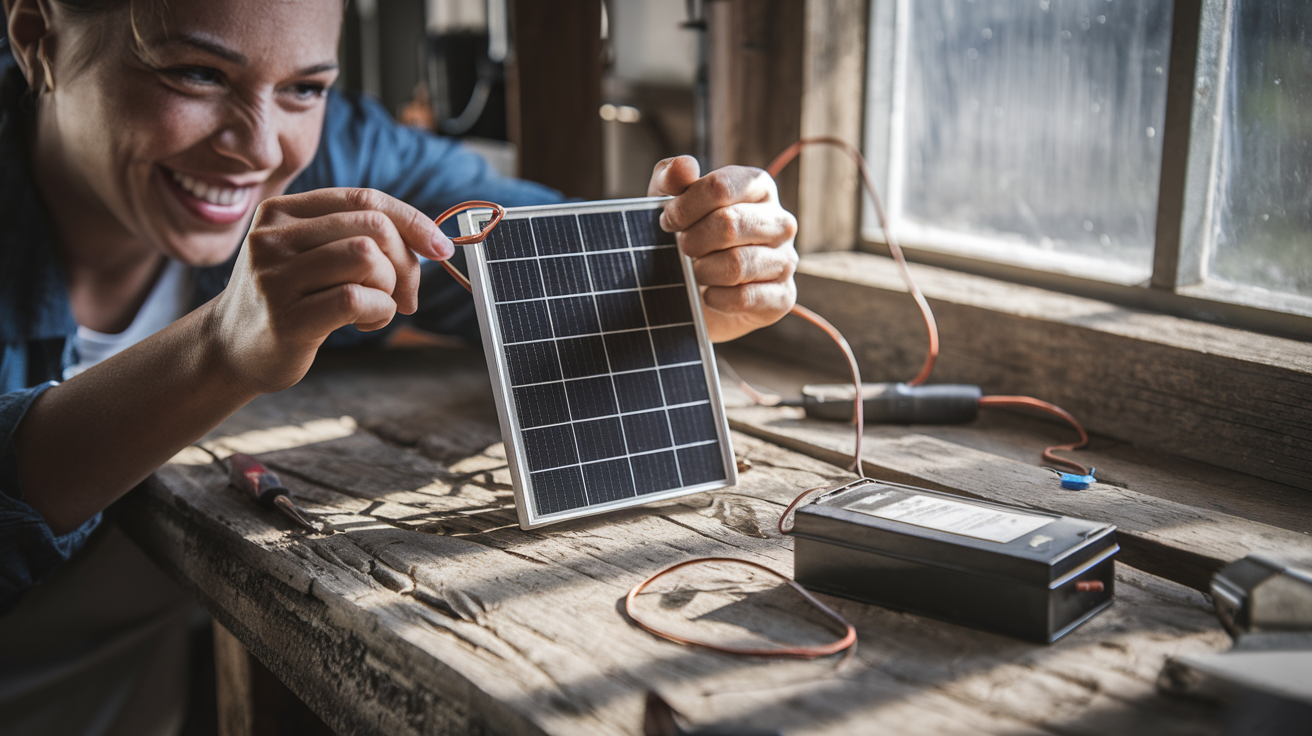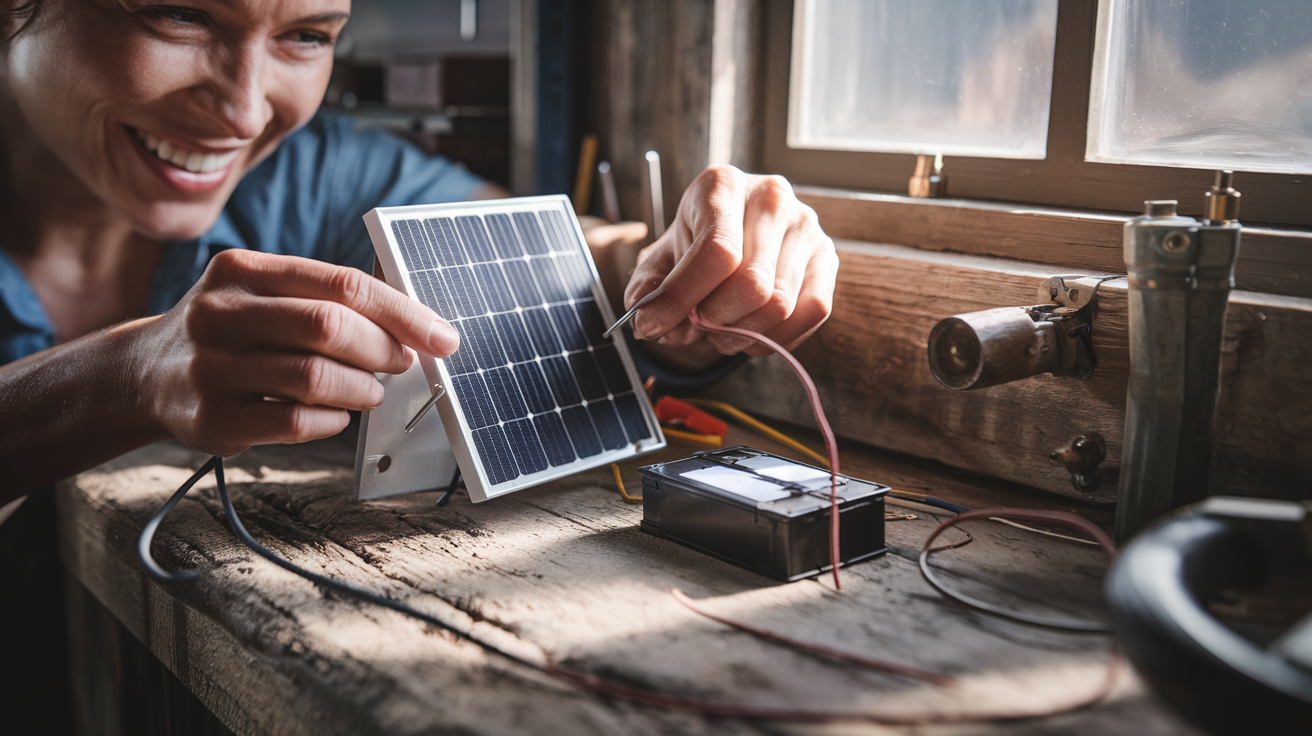Easy DIY Solar Energy Projects For Beginners At Home

Solar power solutions are now more accessible than ever, allowing beginners to tackle home energy independence with low-cost projects and minimal experience. DIY solar power empowers capable DIYers to reduce energy bills, gain resilience, and create functional upgrades using common tools and easy-to-follow guides.
Photovoltaic systems, solar chargers, and solar lighting kits offer immediate benefits, while step-by-step guides and safety considerations make each build approachable.
Whether you want compact gadgets for portable use or foundational upgrades for your system, starter ideas in DIY communities spark creativity and confidence as you harness the sun’s power.
Next, discover starter projects designed to help you build skills and see results quickly.
Your First Solar Power Projects
Jumpstart your renewable energy journey with hands-on learning. Explore foundational concepts of photovoltaic energy generation.
Focus on simple, achievable projects to build confidence. Consider the scalability of these initial efforts.
Simple Solar Energy Starters
Beginner projects such as a solar charger for small devices or self-contained lights introduce you to hands-on DIY solar installation without complex wiring or expensive materials.
Solar ovens and basic solar dehydrators let you explore food preservation and sustainable cooking, using recycled materials and guidance from online tutorials.
With readily available batteries, panels, and connectors from hardware stores, you can create functional setups for garden lights, solar radios, or tiny homes with little more than essential tools.
Safety steps and following step-by-step guides ensure your experience is positive as you grow your skills and plan for larger projects down the road.
Functional Household Applications
Harvesting sun can lead to practical applications with minimal effort. Solar heating, like a basic solar pool heater or solar water systems, can be fashioned from garden hoses and recycled materials, offering cost-effective solutions.
For those seeking portable power or preparing for offgrid scenarios, solar generators provide emergency power or backup power. Assembling these systems is increasingly straightforward with all-in-one kits, requiring minimal setup and offering extra support.
These crafting projects are manageable steps for crafters looking to create functional items for household applications.
Expanding Your Solar Horizons
Capable DIYers can tackle more advanced projects, like expanding small setups for sheds or tiny homes into full household systems.
Modular batteries and expansion kits make scaling your offgrid solar system easier.
While mounting solar panels and determining optimal placement can be managed by skilled individuals, electrical connections for larger systems often benefit from professional assistance. Joining solar communities provides valuable project inspiration, troubleshooting help, and ideas for creative expansion, ultimately leading to greater energy independence and utility savings.

Harness Sun for Home Energy
Solar panels offer a pathway to enhanced energy independence and reduced energy bills. To start your journey in utilizing solar power, analyze your household’s current energy consumption patterns; reviewing utility statements helps tailor your solar solution to actual needs.
Photovoltaic system placement is a critical aspect of DIY solar installation, with rooftops generally offering prime sun exposure.
Unobstructed ground space serves as an alternative for mounting solar panels, particularly when roof orientation or shading might limit effectiveness.
It is important to understand the fundamental differences between basic grid-tied systems, which connect for utility savings, and off-grid solar systems that provide autonomy through batteries for backup power. Consulting professionals for complex electrical connections and ensuring adherence to safety steps are essential for lasting, sustainable energy results.
This review segues into practical applications with beginner-friendly solar projects for home use.
Beginner Projects for Solar Power
Embarking on DIY solar projects provides an accessible gateway to grasping renewable energy concepts through hands-on application. Crafting functional items, such as a solar charger or a solar lighting system, allows you to learn core principles without intricate wiring.
Working with solar cells and batteries introduces an understanding of efficiency factors, from sunlight intensity to cell materials, fostering practical skill development.
Starter ideas include assembling basic low-voltage DC circuits, like solar radios or self-contained lights, utilizing common tools readily available in hardware stores.
Explore easily accessible all-in-one kits that offer manageable steps, and seek guidance from DIY communities or online tutorials to assist with troubleshooting, ensuring safe and cost-effective solutions as you expand your solar capabilities.
Key Takeaways from Solar Energy for Homes
- Reviewing utility statements is recommended to tailor a solar solution to actual energy consumption needs.
- Rooftops are generally considered prime locations for mounting solar panels due to optimal sun exposure, though unobstructed ground space is an alternative.
- Understanding the difference between grid-tied systems (for utility savings) and off-grid solar systems (for backup power via batteries) is crucial.
- Beginner DIY solar projects like solar chargers or lighting systems offer hands-on learning of renewable energy concepts using solar cells and batteries.
Building a Simple Solar Charger
DIY solar projects offer an exciting entry point into leveraging renewable energy, allowing individuals to create useful devices like a solar charger. This particular project focuses on building a portable power source for small electronic devices, teaching fundamental principles of voltage regulation and battery charging.
Selecting appropriate solar panels and charge controllers is key to success.
You can create a portable power source for small electronic devices.
Understand voltage regulation and battery charging principles. Select appropriate solar panels and charge controllers.
Test charging speeds under various light conditions. For a compact gadget, choose a compact 5V solar panel and pair it with a suitable charge controller, such as a TP4056 module, to safely manage lithium or NiMH batteries.
Utilize common tools for assembly and ensure all electrical connections are secured within a sturdy enclosure for safety.
Testing charging speeds under various light conditions allows for adjustments for optimal performance, leading to functional results.
This foundational upgrade provides a tangible understanding of how to harness the sun’s energy.
Easy Solar Lighting Solutions
Solar lighting offers an excellent way to implement cost-effective and eco-friendly illumination for various applications, providing clear renewable energy advantages. Explore different types of solar-powered lamps and fixtures to brighten pathways, gardens, or indoor spaces.
Learners can delve into battery storage and LED efficiency to ensure brighter, longer-lasting light. Consider placement for optimal light exposure to maximize the system’s output.
Solar lighting delivers instant, cost-effective illumination for outdoor pathways, gardens, or indoor ambiance, providing clear renewable energy advantages.
LED fixtures powered by integrated solar panels and rechargeable batteries are readily available, requiring minimal setup for household applications.
Learn about battery storage and LED efficiency. Consider placement for optimal light exposure.
Types of Solar Lighting
Self-contained lights such as motion-sensor floodlights, string lights, or lanterns can enhance both safety and aesthetics for your home. These are often available as low-cost projects.
Placement and Efficiency
Placement is essential; install solar panels in locations with abundant sunlight to ensure reliable performance and longevity.
Adapting panel placement for maximum sun exposure is important.
Benefits of Solar Lighting
The immediate benefits include reduced energy bills and increased resilience, especially in areas prone to outages or natural disasters by utilizing sunlight.
Key Takeaways from Solar Projects
- DIY solar projects allow individuals to create portable power sources for small electronic devices by understanding voltage regulation and battery charging principles.
- Compact 5V solar panels paired with modules like the TP4056 are suitable for safely managing lithium or NiMH batteries in portable chargers.
- Solar lighting offers cost-effective and eco-friendly illumination using integrated solar panels, rechargeable batteries, and LED fixtures.
- Optimal placement of solar panels in locations with abundant sunlight is crucial for reliable performance and maximizing energy capture for both chargers and lighting.
Creating a Solar Dehydrator
Harnessing the sun’s natural heat and energy provides an accessible route to effective food preservation. Designing a functional solar dehydrator transforms this into a rewarding DIY solar endeavor, perfect for those new to renewable energy.
Low-cost projects like these require minimal experience, primarily using readily available materials such as plywood, dark paint, and food-safe mesh.
Begin by creating a well-insulated collector box, ensuring dark interior surfaces absorb thermal energy efficiently.
Clear glazing allows sunlight to penetrate, a key element for effective solar heating. Proper airflow, managed with intake and exhaust vents, is essential for moisture removal.
Good insulation maintains consistent temperatures, promoting reliable drying. Experiment with various foods to discover optimal drying times, gaining foundational food preservation skills through these stepbystep guides.
Materials for Your Solar Dehydrator
Gathering materials is a straightforward process for this cost-effective solution.
Essential tools include common hand tools, making this achievable for most capable DIYers.
You will need plywood for the main structure, dark, heat-absorbent paint for the interior, and a transparent material like acrylic or FRP glazing for the collector lid.
Food-safe mesh or trays are necessary for holding the food, and insulation materials will help maintain optimal temperatures. These components are often readily available at hardware stores, facilitating an efficient build.
Designing for Optimal Airflow and Insulation
A well-designed unit ensures efficient operation.
The collector box should feature dark surfaces to maximize sun absorption and clear glazing to allow sunlight inside. Proper airflow is managed by intake and exhaust vents, which are critical for removing moisture from the drying food.
Good insulation helps maintain steady temperatures, ensuring consistent drying results.
Building this solar dehydrator can be completed with minimal setup and offers immediate benefits in food preservation.
Understanding Offgrid Solar Needs
Transitioning to offgrid solar living involves a careful assessment of your total energy requirements.
Designing a self-sufficient power system independent of the main grid necessitates a clear understanding of your energy demands. Begin by listing every essential appliance and calculating their daily watt-hour needs to ensure your solar power setup delivers functional results and reliable backup power.
Sizing your battery bank, the core of any DIY solar installation, requires mastering amp-hours and depth of discharge. Knowledge of technology choices like lithium-ion or lead-acid batteries, calibrated for your specific load profile, is also key.
Charge controllers, essential safety steps, and appropriate inverter selection complete the core components, empowering individuals with minimal experience to create robust, sustainable energy solutions.
Calculating Your Energy Requirements
Accurately calculating your total energy requirements is the first step towards designing a self-sufficient photovoltaic system.
This involves meticulously listing all appliances and their estimated daily energy consumption in watt-hours.
This number will directly inform the size of your solar panels and battery bank, ensuring your home energy system can reliably meet your needs, leading to greater energy independence and potential utility savings.
Battery Bank Sizing and Management
Mastering battery bank sizing and management is fundamental to successful offgrid solar living. Your battery bank acts as the reservoir for stored solar energy, and its capacity, measured in amp-hours, must align with your daily energy usage.
Understanding depth of discharge—how much energy you can safely draw from the battery without damaging it—is also paramount. Choosing the right battery technology, such as lithium-ion or lead-acid, depends on factors like budget, lifespan, and performance requirements, offering pathways to resilience during outages.
Inverter Selection for Your Loads
Explore inverter selection tailored to your specific loads; this device converts the DC power stored in batteries to the AC power used by most household appliances.
The inverter’s power rating must exceed the combined wattage of all devices you intend to run simultaneously.
Features like pure sine wave output are important for sensitive electronics, ensuring compatibility and preventing damage.
Selecting the right inverter is a critical step in creating a functional and reliable DIY solar power system for your home, contributing to energy independence.
Key Takeaways for DIY Solar Projects
- Solar dehydrators are accessible DIY projects for food preservation, requiring minimal experience and readily available materials like plywood, dark paint, and food-safe mesh.
- Designing a solar dehydrator involves creating an insulated collector box with dark interior surfaces for heat absorption and clear glazing for sunlight penetration, along with intake and exhaust vents for moisture removal.
- Offgrid solar system design necessitates calculating total energy requirements by listing appliances and their daily watt-hour needs to properly size solar panels and battery banks.
- Battery bank sizing for offgrid systems depends on understanding amp-hours and depth of discharge, with technology choices like lithium-ion or lead-acid impacting budget, lifespan, and performance.
Exploring Creative Solar Applications
Solar power presents an exciting avenue for DIY solar enthusiasts to explore creative applications beyond simple charging. Crafting a functional solar radio offers a rewarding entry into harnessing sunlight for entertainment and information, providing immediate benefits.
This involves utilizing salvaged solar panels from common garden lights and a basic AM/FM circuit, coupled with rechargeable batteries and a charge controller, to create a self-contained gadget.
Online tutorials and DIY communities offer ample guidance for assembling these compact devices, demonstrating the practical outcomes of pursuing renewable energy.
Similarly, engaging with solar thermal energy for cooking introduces principles of concentrating sunlight to prepare food, a hands-on approach to sustainable energy.
Building a Solar Radio
Solar radios, accessible starting points for beginner projects, demonstrate the principles of renewable energy with minimal experience.
Gathering materials like small solar panels, a basic radio circuit, rechargeable batteries, and a charge controller from local hardware stores or salvaged items allows for the creation of an independent power source for news and music. This introduction to DIY solar empowers individuals to connect with home energy solutions and achieve tangible results with simple tools.
Constructing a Solar Oven
The construction of a solar oven serves as a practical example of concentrating solar thermal energy for cooking, offering functional results with a focus on sustainable energy.
This project often involves repurposing boxes, lining them with reflective materials like foil, and incorporating a glass top to trap heat, illustrating the harnessing of sunlight effectively for food preservation and preparation.
While these projects are generally low-cost and require minimal setup, observing critical safety considerations, such as using mitts to avoid burns and ensuring the oven’s stability, is paramount.
DIY Solar Projects for Home Energy
DIY solar projects offer accessible pathways to reduce utility savings and boost energy independence, perfect for those with minimal experience embarking on low-cost projects.
These endeavors provide practical tips and step-by-step guides to achieve functional results, transforming sunlight into power for various applications. From compact gadgets to foundational upgrades, the world of solar power is within reach for capable DIYers seeking sustainable energy solutions.
Compact Gadget Creations
Beginner projects in DIY solar often start with creating compact gadgets, requiring minimal experience and readily available materials from hardware stores.
Simple solar chargers for phones or solar lighting solutions are excellent starter ideas, demonstrating how solar cells and basic components can yield immediate benefits.
These small setups offer a taste of energy independence and are manageable steps for anyone looking to explore renewable energy at home.
Foundational Home Upgrades
For those ready for foundational upgrades, expanding into projects like solar heating or solar dehydrators utilizes sunlight for practical home applications, showcasing sustainable energy principles.
These advancements, while requiring slightly more involved assembly, connect individuals to the benefits of home energy management and offer a pathway to greater energy independence. The journey from simple gadgets to more substantial systems allows for continuous learning and creative expansion within the DIY solar realm.
Key Takeaways from Creative Solar Applications
- DIY solar projects like building a solar radio offer practical applications of renewable energy using salvaged solar panels from garden lights and basic electronic components.
- Constructing a solar oven is a hands-on method to understand solar thermal energy, involving simple materials like repurposed boxes and reflective surfaces to concentrate sunlight for cooking.
- Beginner DIY solar projects often focus on compact gadgets such as solar chargers or lighting, demonstrating the immediate benefits of solar cells and basic components for energy independence.
- More advanced DIY solar projects, like solar heating or dehydrators, allow individuals to manage home energy and increase energy independence by utilizing sunlight for practical applications.




